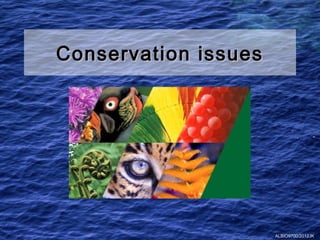
02 Conservation Issues
- 1. Conservation issues ALBIO9700/2012JK
- 2. Biodiversity • The total number of different species/range of communities living in a defined area, ecosystem or biome – Huge interdependence between species and biodiversity is essential to maintain ecological balance and stability • Extent of genetic diversity with species and populations – Essential for the stability and survival of a species ALBIO9700/2012JK
- 3. Biodiversity
- 4. Biodiversity Loss and Species Extinction: Remember HIPPO • H for habitat destruction and degradation • I for invasive species • P for pollution • P for human population growth • O for overexploitation ALBIO9700/2012JK
- 5. The need to maintain Biodiversity • Biological reasons: – Ecological balance and stability – Diverse gene pools within populations and the genetic diversity of species is extremely important if species are to be prevented from becoming extinct • Human reasons: – For use in agriculture – potential food supplies or to be crossed with existing agricultural species to improve features (yield, hardiness or disease resistance) – To provide possible medicines (7000 drugs in the UK derived from plants) – To encourage tourism in some countries – ecotourism – Obligation to reverse the decline in biodiversity and also to try and maintain the current level of biodiversity for future generations ALBIO9700/2012JK
- 6. Reasons why species have become endangered • Endangered species - any species whose numbers have become so low that they are unlikely to be maintained by normal rates of reproduction and are in danger of becoming extinct. • African elephant – Habitat loss – competition between humans and elephants for space, trees and grazing leading to loss and fragmentation of the elephant habitat – Contact with humans – protection of villages – Hunting – trophies, ivory and ‘bushmeat’ – Poaching – illegal hunting – IUCN Red list status = 2008 ( Near Threatened) – CITES Listing Appendix I except Botswana, Namibia, South Africa and Zimbabwe & Appendix II • Orangutan ALBIO9700/2012JK
- 9. Methods of protecting endangered species • Zoos – Advantage of captive breeding: • Possible to monitor the health of the mother and the development of the fetus during the pregnancy • Sperm and eggs can be obtained from the captive individuals • These can be stored in a frozen form • It allows the possibility of artificial insemination • Also in-vitro fertilisation • Fertilised embryos may be implanted in surrogate mothers (might even be different species) • There is a possibility of international co-operation and the transfer of breeding individuals between different zoos • It allows the keeping of breeding records and the genetic relatedness of captive individuals – Golden lion tamarin; Californian Condor; Black-footed ferret; Cheetah; Arabian oryx; Red wolf ALBIO9700/2012JK
- 10. ALBIO9700/2012JK
- 11. • Captive breeding – Reasons why animals do not always breed successfully when in captivity: • No longer living in their natural habitat • Conditions experienced in captivity can cause stress and behavioural changes • The stress can disrupt normal reproductive cycles and breeding behaviour • They often have little choice of mate and may reject the chosen mate • Release of captive-bred individuals into the wild – Problems that reduce success rate of releasing captive-bred individuals: • Habitat destruction might mean that there is very little suitable habitat available to release the animals • Animals might not find it easy to move around in their natural habitat • It may not be easy for them to find enough food • They may not be able to communicate with other members of their species in the wild and may not integrate into social groups • They may be susceptible to diseases in the wild ALBIO9700/2012JK
- 12. • Botanic gardens – Plants can be grown in botanic gardens – Possible to create ideal growing conditions (availability of light, nutrients, water and the atmospheric conditions) – Also possible to propagate endangered species (by seed, vegetative or tissue culture) – Allows possibility of re-introducing endangered species of plants into their natural habitat – Botanic Gardens Conservation International; Royal Botanic Gardens, Kew, London • Seed banks – Collection of seeds that are long-lived and can be stored in a relatively small space – Life span of such seeds can be extended if they are kept in carefully controlled conditions (atmosphere of low oxygen levels, moisture and temperature) – Gene pool of a particular species is also maintained – Seeds of endangered species can be germinated at any time and plants can be grown in Botanic gardens or restored to the wild – Some species produce seeds which have a limited longevity (e.g. cocoa, rubber, coconut) – such plants would need to be maintained in botanic gardens – The Millenium Seed Bank at Wakehurst Place, UK ALBIO9700/2012JK
- 13. ALBIO9700/2012JK
- 14. Pictures taken from www.eyematter.com ALBIO9700/2012JK
- 15. • National Parks (and other protected areas) – Set up to conserve rare/endangered species and maintain important habitats – Legislation is passed to ensure that such areas are protected under the law – The ways in which National Parks protect their resident species include: • Wardens, rangers and volunteers can be used to patrol the parks • Access by humans can be restricted (footpaths are created) • Agricultural activities can be strictly controlled • Industrial activities and mining can be limited and controlled • The building of roads, dwellings and other developments can be strictly controlled • Visitor Centres can be established to educate the general public in the importance of conservation within the Park and elsewhere • Wildlife can be protected directly e.g. 24 hour surveillance of nests/breeding sites – In addition to National Parks, other categories of conservation areas can be created if they contain species or habitat which need some form of protection (e.g. SSSIs - http://www.english- nature.org.uk/special/sssi/) ALBIO9700/2012JK
- 16. Yellowstone Fiordland Galapagos Kruger ALBIO9700/2012JK ALBIO9700/2006JK
